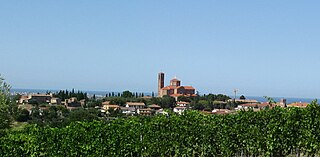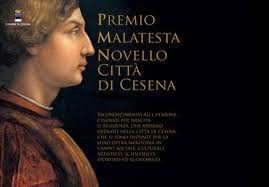
Fano is a town and comune of the province of Pesaro and Urbino in the Marche region of Italy. It is a beach resort 12 kilometres southeast of Pesaro, located where the Via Flaminia reaches the Adriatic Sea. It is the third city in the region by population after Ancona and Pesaro.
Malatesta da Verucchio (1212–1312) was the founder of the powerful Italian Malatesta family and a notable condottiero. He was born in Verucchio. He was the son of Malatesta della Penna (1183-1248).

Sigismondo Pandolfo Malatesta was an Italian condottiero and nobleman, a member of the House of Malatesta and lord of Rimini and Fano from 1432. He was widely considered by his contemporaries as one of the most daring military leaders in Italy and commanded the Venetian forces in the 1465 campaign against the Ottoman Empire. He was also a poet and patron of the arts.

The province of Rimini is the southernmost province of the Emilia-Romagna region of Italy. Its capital is the city of Rimini, one of the "seven sisters" of the historical region of Romagna.

Coriano is a comune in the province of Rimini. This town is known for being the town of the Motorcycle World Champion, in 250cc class, Marco Simoncelli.
Pandolfo I Malatesta, son of Malatesta da Verucchio, was an Italian condottiero and Lord of Rimini from 1317.
Pandolfo III Malatesta was an Italian condottiero and lord of Fano, a member of the famous House of Malatesta. He was the father of the infamous Sigismondo Pandolfo Malatesta and Blessed Roberto Malatesta.

Roberto Malatesta was an Italian condottiero, or mercenary captain, lord of Rimini, and a member of the House of Malatesta.
Carlo I Malatesta was an Italian condottiero during the Wars in Lombardy and lord of Rimini, Fano, Cesena and Pesaro. He was a member of the powerful House of Malatesta. Carlo's wife was Elisabetta Gonzaga; they were married in November 1386. Francesco I Gonzaga married Carlo's sister Margherita Malatesta in 1393, cementing ties between the families. Carlo was the brother of Pandolfo III and Andrea Malatesta, with whom he fought in numerous occasions.
Malatesta II Malatesta, best known as Guastafamiglia was an Italian condottiero and lord of Rimini.
Malatesta Malatesta may refer to:

Paolo Malatesta, also known as il Bello, was the third son of Malatesta da Verucchio, Lord of Rimini. He is best known for the story of his affair with Francesca da Polenta, portrayed by Dante in a famous episode of his Inferno. He was the brother of Giovanni (Gianciotto) and Malatestino Malatesta.
Ferrantino Malatesta was a lord of Rimini and several other lands in northern Italy, a member of the Malatesta family.
Galeotto I Malatesta (1299–1385) was an Italian condottiero from the House of Malatesta who was lord of Rimini, Fano, Ascoli Piceno, Cesena and Fossombrone.
Andrea Malatesta was an Italian condottiero, a member of the Malatesta family of Romagna. He is also known as Malatesta da Cesena, a city he had inherited in 1385 from his father, Galeotto, together with Cervia and Bertinoro. In 1388 he was also recognized lord of Fossombrone.

Domenico Malatesta, best known as Malatesta Novello was an Italian condottiero, a member of the Malatesta family.
Galeotto Roberto Malatesta (1411–1432) was an Italian condottiero and blessed of the Catholic Church.
Ramberto Malatesta was a son of Giovanni Malatesta and his second wife Zambrasina dei Zambrasi, and brother of the Archpriest Guido Malatesta.
The following is a timeline of the history of the city of Rimini in the Emilia-Romagna region of Italy.















